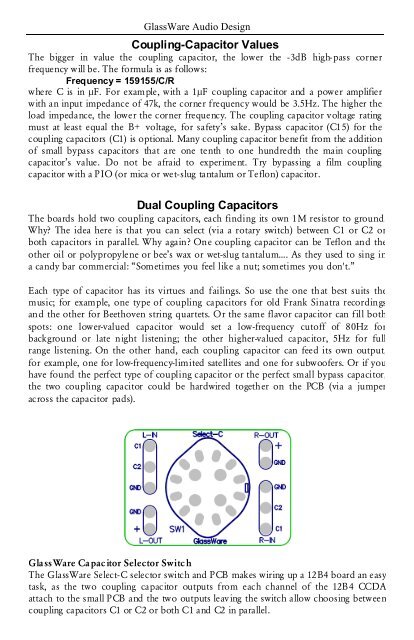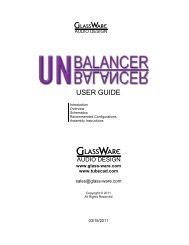You also want an ePaper? Increase the reach of your titles
YUMPU automatically turns print PDFs into web optimized ePapers that Google loves.
GlassWare Audio Design<br />
Coupling-Capacitor Values<br />
The bigger in value the coupling capacitor, the lower the -3dB high-pass corner<br />
frequency will be. The formula is as follows:<br />
Frequency = 159155/C/R<br />
where C is in µF. For example, with a 1µF coupling capacitor and a power amplifier<br />
with an input impedance of 47k, the corner frequency would be 3.5Hz. The higher the<br />
load impedance, the lower the corner frequency. The coupling capacitor voltage rating<br />
must at least equal the B+ voltage, for safety’s sake. Bypass capacitor (C15) for the<br />
coupling capacitors (C1) is optional. Many coupling capacitor benefit from the addition<br />
of small bypass capacitors that are one tenth to one hundredth the main coupling<br />
capacitor’s value. Do not be afraid to experiment. Try bypassing a film coupling<br />
capacitor with a PIO (or mica or wet-slug tantalum or Teflon) capacitor.<br />
Dual Coupling Capacitors<br />
The boards hold two coupling capacitors, each finding its own 1M resistor to ground.<br />
Why The idea here is that you can select (via a rotary switch) between C1 or C2 or<br />
both capacitors in parallel. Why again One coupling capacitor can be Teflon and the<br />
other oil or polypropylene or bee’s wax or wet-slug tantalum…. As they used to sing in<br />
a candy bar commercial: “Sometimes you feel like a nut; sometimes you don't.”<br />
Each type of capacitor has its virtues and failings. So use the one that best suits the<br />
music; for example, one type of coupling capacitors for old Frank Sinatra recordings<br />
and the other for Beethoven string quartets. Or the same flavor capacitor can fill both<br />
spots: one lower-valued capacitor would set a low-frequency cutoff of 80Hz for<br />
background or late night listening; the other higher-valued capacitor, 5Hz for full<br />
range listening. On the other hand, each coupling capacitor can feed its own output,<br />
for example, one for low-frequency-limited satellites and one for subwoofers. Or if you<br />
have found the perfect type of coupling capacitor or the perfect small bypass capacitor,<br />
the two coupling capacitor could be hardwired together on the PCB (via a jumper<br />
across the capacitor pads).<br />
GlassWare Capacitor Selector Switch<br />
The GlassWare Select-C selector switch and PCB makes wiring up a <strong>12B4</strong> board an easy<br />
task, as the two coupling capacitor outputs from each channel of the <strong>12B4</strong> <strong>CCDA</strong><br />
attach to the small PCB and the two outputs leaving the switch allow choosing between<br />
coupling capacitors C1 or C2 or both C1 and C2 in parallel.

















